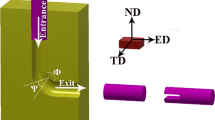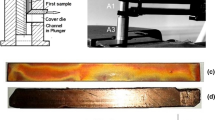Abstract
Cu0.4Cr0.3Zr alloy was extruded by equal-channel angular pressing (ECAP)-BC path at room temperature and aged at 450°C for 1 h. Scanning electron microscopy (SEM), energy-dispersive spectroscopy (EDS), electron backscatter diffraction (EBSD) and transmission electron microscopy (TEM) were used to detect the microstructure, mechanical properties and electrical conductivity of the materials during deformation and aging. The effect of cyclic loading alternating shear stress on the microstructure transformation and properties of the materials was analyzed, and the dynamic mechanism of the formation and evolution of micro/nano precipitates in the process was explored. The results show that the cellular structure formed in the matrix at the early stage of deformation can be rapidly transformed into micro/nano structure by ECAP alternating shear and aging treatment. Supersaturated Cr and Zr are dispersed in the crystal, and Cr, Zr and CuxZr intermetallic compounds are precipitated discontinuously at the grain boundary. The alloy strength reached 538.6 MPa and the conductivity was 74.9% IACS. The improvement of tensile strength and microhardness of the alloy is attributed to the interaction of grain refinement, dislocation strengthening and precipitation strengthening during plastic deformation and aging treatment. The high conductivity is mainly attributed to the precipitation of nano-Cr during the subsequent aging treatment.










Similar content being viewed by others
References
Q, Wang, A brief talk on the application of smart high-speed multiple fusion sensing technology under the background of new infrastructure. China. ITS. J. 06, 125 (2020).
Z. Li, Z. Xiao, Y.B. Jiang, Q. Lei, and J.X. Xie, Composition design, phase transformation and preparation of high strength conductive copper alloy. Chin. J. Nonferrous. Met. 29, 2009 (2019).
F.S. Xu, Study on ECAP Cu-Cr-Zr alloys applied to the contact line. N. Univ. Tech. (2012). https://doi.org/10.7666/d.y2062109.
R. Liu, H. Zhou, X. Zhou, L.U. Deping, K. Liu, Q. Peng, Y. Peng, and F. Zhong, Present situation and future prospect of high-strength and high-conductivity Cu alloy. Mater. Rev. 26, 100 (2012).
Y. Wang, X.Q. Li, R.Q. Li, and Y. Tian, Fine grain mechanism of ultrasonic vibration depth in large diameter aluminum ingot hot-top casting. Chin. J. Eng. 41, 96 (2019).
S. Wen, B. Wang, C. Zhao, X. Wang, and Q. Hou, Study on microstructure and hardness of direct-current electrodeposited nanotwinned Cu. Hot. W. Techno. 46, 107 (2017).
J.Y. Wen, Study status and applications of preparation methods of high strength and high conductivity copper alloy. Metal. Mater. Metall. Eng. 45, 3 (2017).
A. Knaislová, V. Šimůnková, P. Novák, F. Průša, M. Cabibbo, L. Jaworska, and D. Vojtěch, Effect of alloying elements on the properties of Ti-Al-Si alloys prepared by powder metallurgy. J. Alloy. Compd. 868, 15925 (2021).
J. Cao and L. Zheng, Strengthening method and research hotspots of high strength and high conductivity copper alloy. Foundry. Tech. 39, 1637 (2018).
Z.Y. Li, J. Shen, F.Y. Cao, and C. Qing, A high strength and high conductivity copper alloy prepared by spray forming. J. Mater. Process. Tech. 137, 60 (2003).
C. Suryanarayana, Mechanical alloying and milling. Prog. Mater. Sci. 46, 1 (2006).
M. Guo, M. Wang, L. Zhou, J. Cheng, and L. Cao, Different ceramic particle dispersion strengthening Cu alloys prepared by mechanical alloying. Chin. J. Rare. Metals. 28, 926 (2004).
H.B. Feng, Y. Zhou, and D.C. Jia, Principle and application of spark plasma sintering technology. Mater. Sci. Tech. 11, 327 (2003).
V.M. Segal, Materials processing by simple shear. Mat. Sci. Eng. A-Struct. 197, 157 (1995).
L. Lu and K. Lu, Metallic materials with nano-scale twins. Acta. Metall. Sin. 46, 1422 (2010).
L. Lu and Z.S. You, Plastic deformation mechanisms in nanotwinned metals. Acta Metall. Sin. 50, 129 (2014).
Y.F. Shen, L. Lu, Q.H. Lu, Z.H. Jin, and K. Lu, Tensile properties of copper withnano-scale twins. Scr. Mater. 52, 989 (2005).
L. Lu, Y.F. Shen, X.H. Chen, L.H. Qian, and K. Lu, Ultrahigh strength and high electrical conductivity in copper. Science 304, 422 (2004).
R. Mishnev, I. Shakhova, A. Belyakov, and R. Kaibyshev, Deformation microstructures, strengthening mechanisms, and electrical conductivity in a Cu–Cr–Zr alloy. Mat. Sci. Eng. A-Struct. 629, 29 (2015).
L.X. Sun, N.R. Tao, and K. Lu, A high strength and high electrical conductivity bulk CuCrZr alloy with nanotwins. Scri. Mater. 99, 73 (2015).
G. Purcek, H. Yanar, M. Demirtas, Y. Alemdag, D.V. Shangina, and S.V. Dobatkin, Optimization of strength, ductility and electrical conductivity of Cu-Cr-Zr alloy by combining multi- route ECAP and aging. Mat. Sci. Eng. A-Struct. A 649, 114 (2016).
T.B. Guo, Q. Li, C. Wang, F. Zhang, and Z. Jia, Deformation characteristics and mechanical properties of single crystal copper during equal channel angular pressing by route A. Acta. Metall. Sin. 08, 991 (2017).
I.A. Faizov, R.R. Mulyukov, D.A. Aksenov, S.N. Faizova, and Y. Zeng, Dissolution of the second phase particles in the course of the equal channel angular pressing of diluted CuCrZr alloy. Lett. Mater. 8, 110 (2018).
Z.Y. Ding, S.G. Jia, X.M. Ning, K.X. Song, and P. Liu, Aging properties of high strength and high conductivity Cu Cr Zr alloy. Chin. J. Nonferrous. Met. 027, 2420 (2017).
Z.L. Chen, C.X. Gu, and X.H. Ren, Effect of cold deformation on aging properties of Cu Ni Si alloy. Electr. Eng. Mater. 04, 7 (2016).
Funding
Funding was provided by National Natural Science Foundation of China (Grant Nos. 51861022, 51261016).
Author information
Authors and Affiliations
Corresponding author
Ethics declarations
Conflict of interest
All authors declare that they have no conflicts of interest.
Additional information
Publisher's Note
Springer Nature remains neutral with regard to jurisdictional claims in published maps and institutional affiliations.
Rights and permissions
Springer Nature or its licensor (e.g. a society or other partner) holds exclusive rights to this article under a publishing agreement with the author(s) or other rightsholder(s); author self-archiving of the accepted manuscript version of this article is solely governed by the terms of such publishing agreement and applicable law.
About this article
Cite this article
Guo, T., Wang, H., Qian, D. et al. Effect of ECAP by Route BC and Aging Heat Treatment on the Structure and Properties of Cu0.4Cr0.3Zr Alloy. J. Electron. Mater. 53, 196–206 (2024). https://doi.org/10.1007/s11664-023-10730-1
Received:
Accepted:
Published:
Issue Date:
DOI: https://doi.org/10.1007/s11664-023-10730-1




